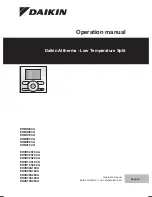
Local Registers
Type
Description
846–849
32-bit integer
Reset, Constant, Timer
851–900
32-bit non-volatile integer
Data flash, non-volatile
901–1000
Reserved for internal use
1001–5000
Floating point
Floating point registers, local data registers
5001–7000
32-bit integer
Local data registers
7001–8000
32-bit non-volatile integer
Data flash, non-volatile
> 10000
Read only virtual registers, system-level data
Local registers 1–850 and 5001–7000
(Internal Processor Memory, 32-bit, Unsigned)—The local registers are the main
global pool of registers. Local registers are used as basic storage registers and as the common data exchange mechanism.
External Modbus device registers can be read into the local registers or written from the local registers. The DXM, as a
Modbus master device or a Modbus slave device, exchanges data using the local registers. Modbus over Ethernet (Modbus/
TCP) uses the local registers as the accessible register data.
Local registers 851–900 and 7001–8000
(Data Flash, Non-volatile, 32-bit, Unsigned)—The top 50 local registers are
special non-volatile registers. The registers can store constants or calibration type data that must be maintained when power
is turned off. This register data is stored in a data flash component that has a limited write capability of 100,000 cycles, so
these registers should not be used as common memory registers that change frequently.
Local registers 1001–5000
— These local registers are paired together to store a 32-bit IEEE floating point format number in
big endian format. Registers 1001 [31:16], 1002 [15:0] store the first floating point value; registers 1003, 1004 store the
second floating point number. There are a total of 2000 floating point values; they are addressed as two 16-bit pieces to
accommodate the Modbus protocol. Use these registers when reading/writing external devices that require Modbus registers
in floating point format. Since Modbus transactions are 16-bits, the protocol requires two registers to form a 32-bit floating
point number.
Virtual registers
—The DXM has a small pool of virtual registers that show internal variables of the main processor. Some
register values will be dependent upon the configuration settings of the DXM. Do not use
Read Rules
to move virtual local
registers data into local registers. Use the
Action Rule
>
Register Copy
function to move virtual local registers into local
registers space (1–850).
Table 28: Modbus registers for virtual registers
Registers
Definition
10001
GPS latitude direction (N, S, E, W)
GPS Coordinate Data if the DXM is configured to read an external GPS unit.
10002
GPS latitude
10003
GPS longitude direction (N, S, E, W)
10004
GPS longitude
10011–10012
Resync timer
Engineering use
10013–10014
Resync timer rollover
Engineering use
10015–10016
Reboot cause (Restart Codes above)
Reboot Type
10017–10018
Watchdog reset count
Counter to track how many resets have been caused by the Watchdog
10021
IO Board Battery Voltage (mV)
mV
10022
IO Board - Incoming Supply Voltage (mV)
mV
10023
IO Board Voltage Cut-off Feature
0—No successful readings
1—Normal range
2—Cut-off engaged
10024
IO Board - Battery Charging Current (mA)
mA
10025–10026
Http Push SSL Acquires
Statistical counts of connections, disconnections and forced disconnects when
the DXM creates a connection using SSL/TLS (Encrypted connections)
10027–10028
Http Push SSL Releases
10029–10030
Http Push SSL Forced Releases
10031–10032
Http Push Attempts
Statistical counts of connections, disconnections and forced disconnects when
the DXM controller creates a connection using HTTP non-encrypted
Sure Cross
®
DXM100-Bx and DXM1000-Bx Wireless Controllers
www.bannerengineering.com - Tel: + 1 888 373 6767
75
















































